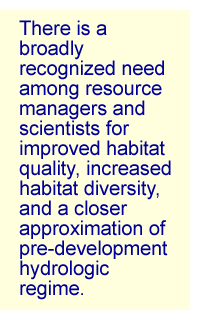Upper Midwest Environmental Sciences Center
|
|
This summary report describes the first Habitat Needs Assessment (HNA),
in support of the Upper Mississippi River System (UMRS), Environmental
Management Program (EMP). The EMP Habitat Needs Assessment was designed
to help guide future Habitat Rehabilitation and Enhancement Projects on
the UMRS. The Habitat Needs Assessment identified clear differences in habitat types and conditions among river reaches. Those differences are largely related to the amount and distribution of public land, the degree of floodplain development, the geomorphic form of the river, and the effects of impoundment for Executive Summary navigation. The differences also suggest that habitat needs and restoration objectives will vary by river reach and pool. The Habitat Needs Assessment yielded gross quantitative and qualitative estimates of habitat needs both system-wide and within river reaches. These estimates provide the first approximation of a set of system-wide objectives for Habitat Rehabilitation and Enhancement Projects. While they do not offer quantitatively precise goals, they will help focus future planning on the most important geomorphic processes both system-wide and in specific river reaches. However, perhaps the greatest contribution this first Habitat Needs Assessment has made is the development of new and improved tools for future planning for Habitat Rehabilitation and Enhancement Projects. In particular, the GIS Query tool will help evaluate the potential distribution of species and habitat area types throughout the UMRS. While the results of the Habitat Needs Assessment are not a substitute for the more detailed and spatially explicit planning that will be done at the pool scale, it has provided new tools for that planning. The Future |
|
|



 To identify habitat needs, historical, existing, forecast, and desired
future conditions were compared. Issues of scale are important in this
regard because ecological processes and needs vary at the system, reach,
and pool levels. In addition, a wide variety of habitat characteristics
must be addressed including habitat fragmentation, connectivity, and diversity.
To accomplish this assessment, a GIS tool and a new floodplain vegetation
successional model were developed. These tools allow geomorphic and land
cover characteristics to be translated into the potential habitat areas
for species to occur.
To identify habitat needs, historical, existing, forecast, and desired
future conditions were compared. Issues of scale are important in this
regard because ecological processes and needs vary at the system, reach,
and pool levels. In addition, a wide variety of habitat characteristics
must be addressed including habitat fragmentation, connectivity, and diversity.
To accomplish this assessment, a GIS tool and a new floodplain vegetation
successional model were developed. These tools allow geomorphic and land
cover characteristics to be translated into the potential habitat areas
for species to occur. 